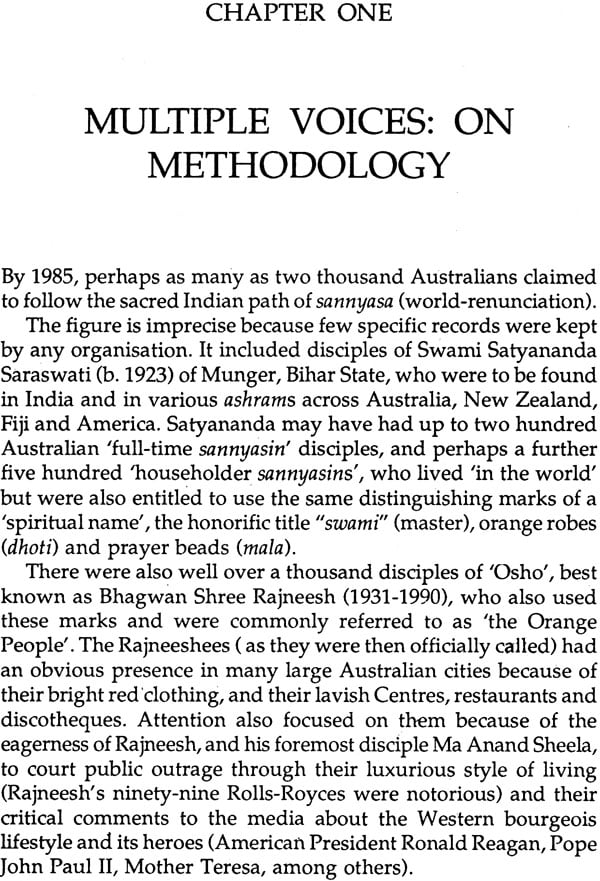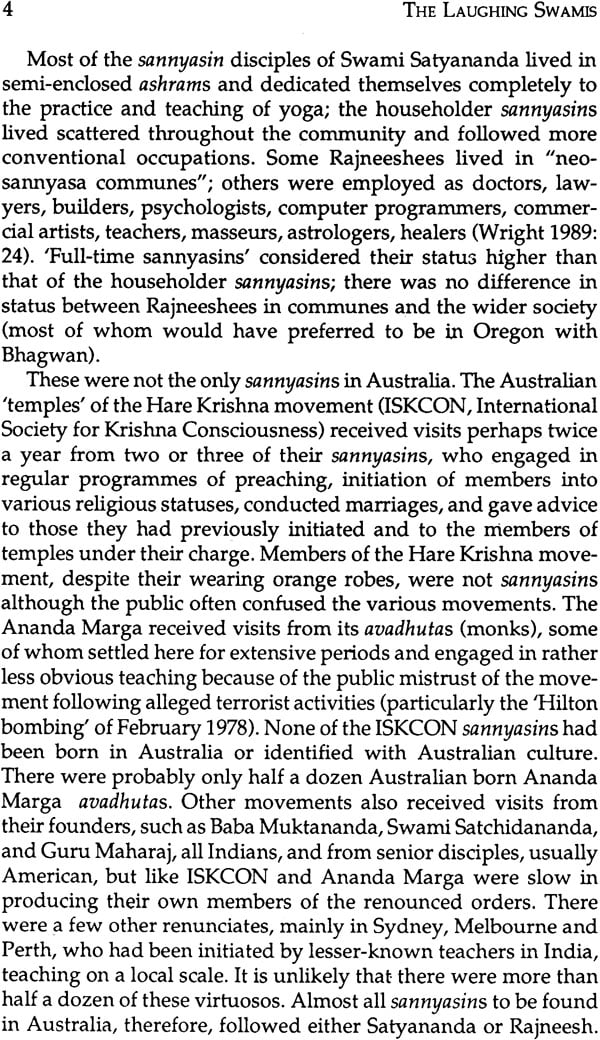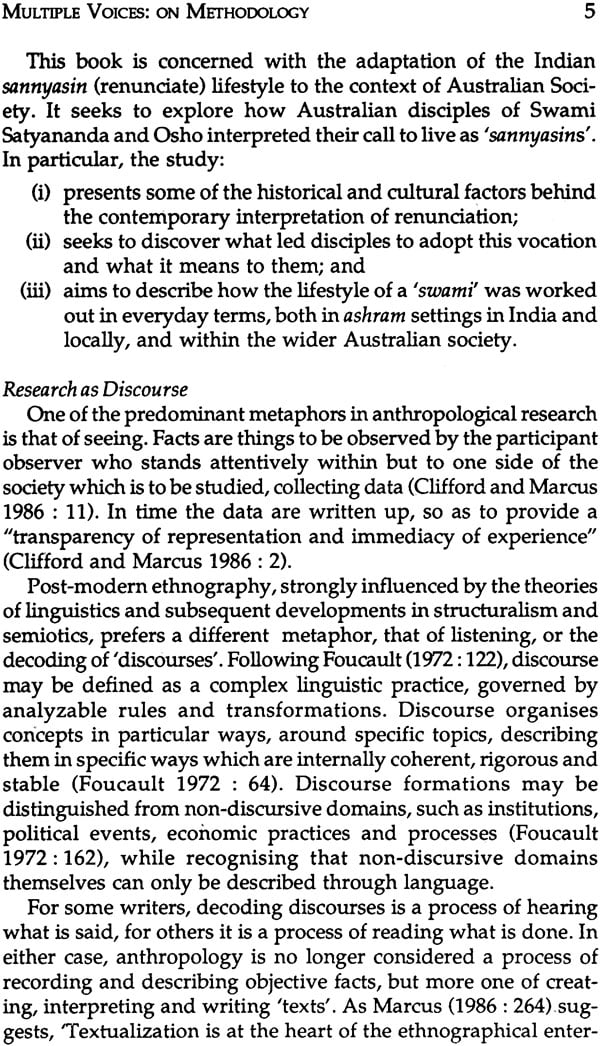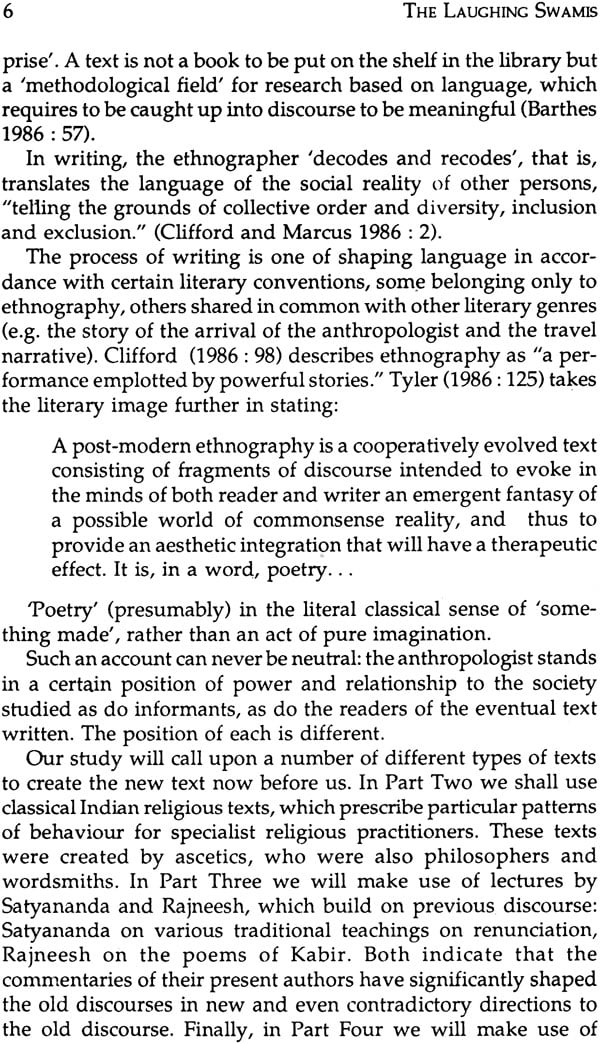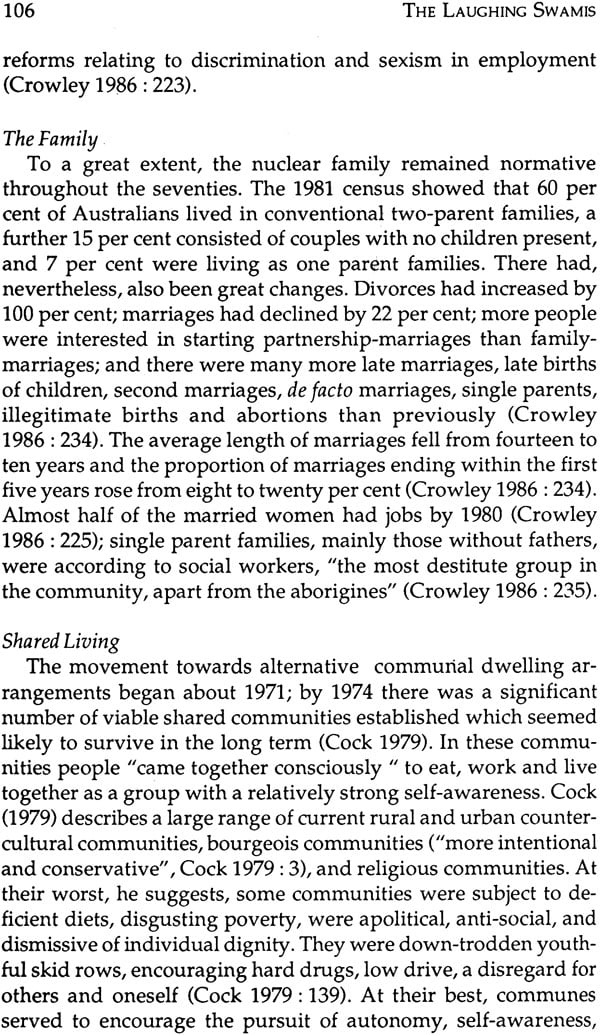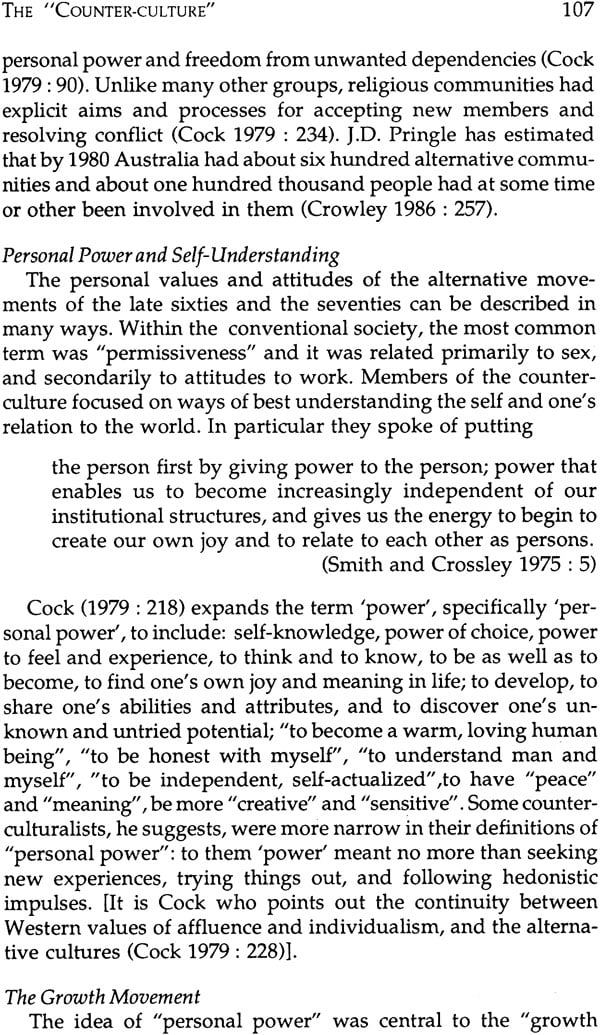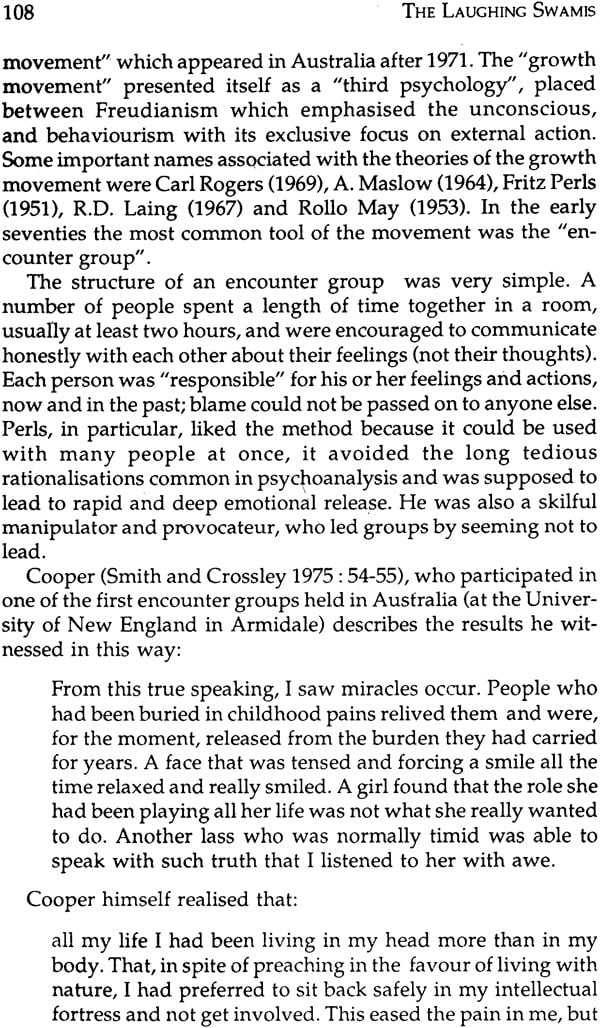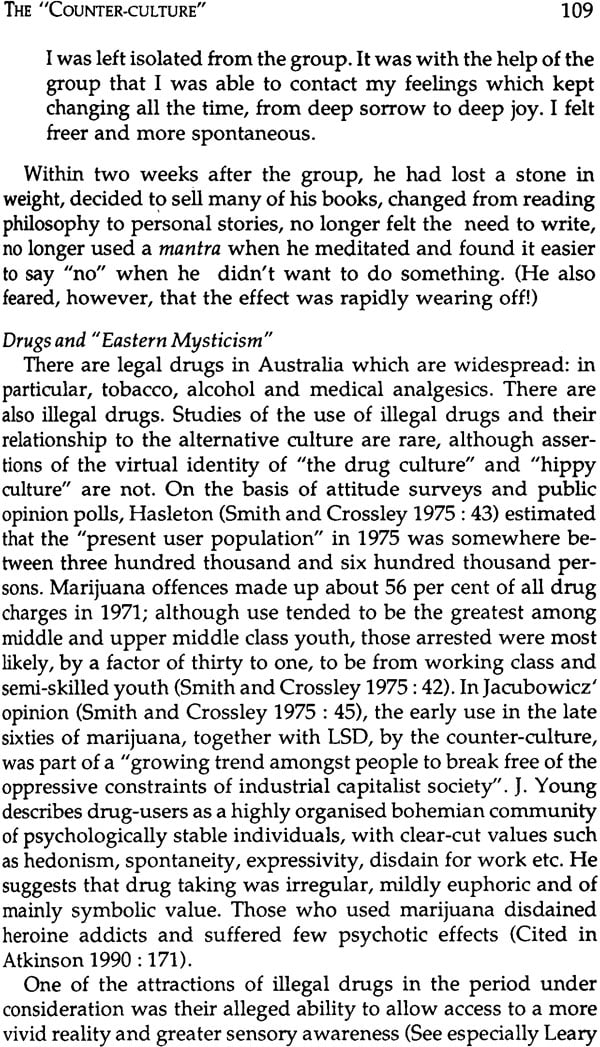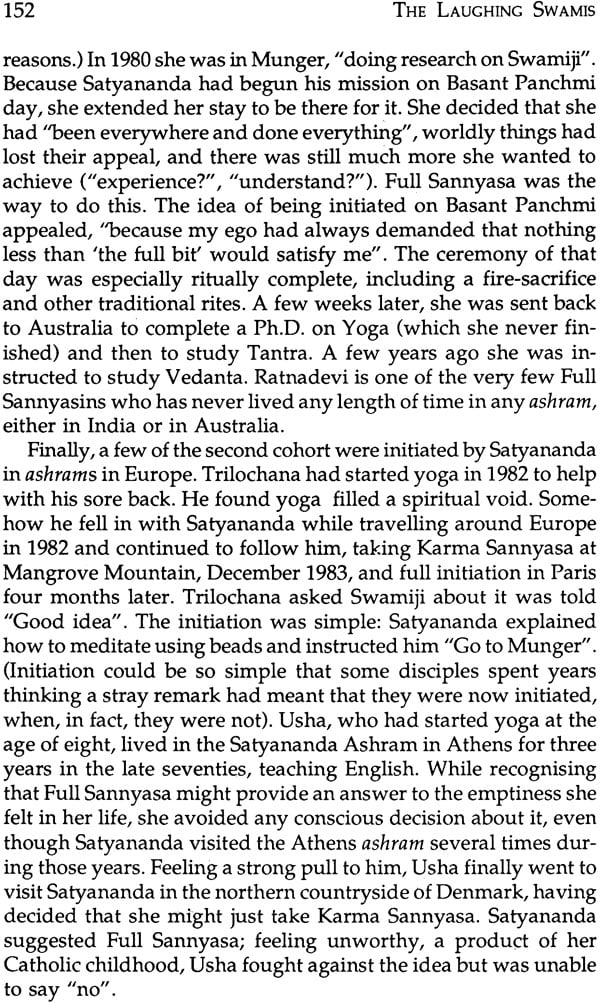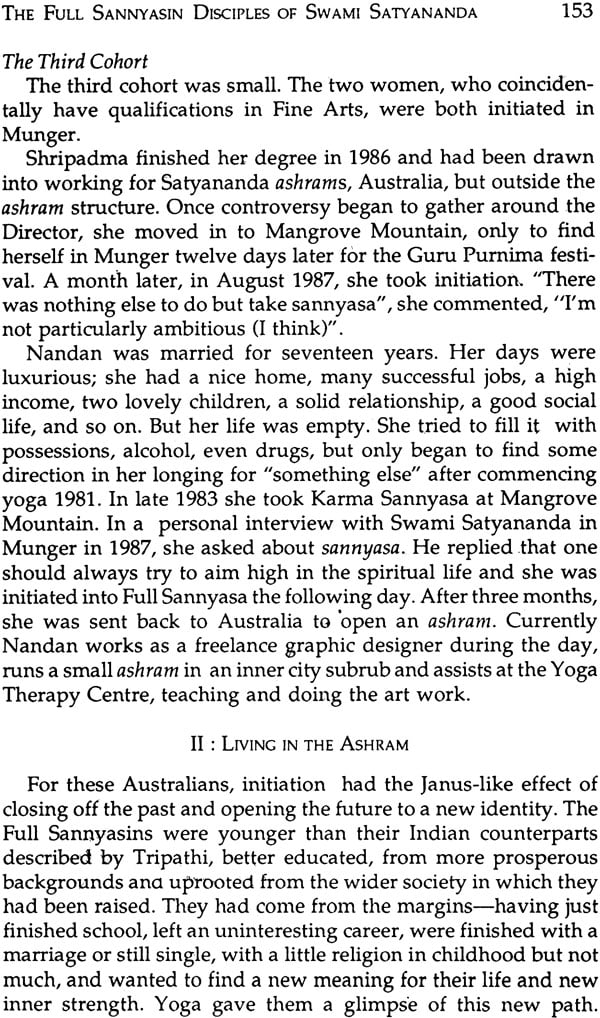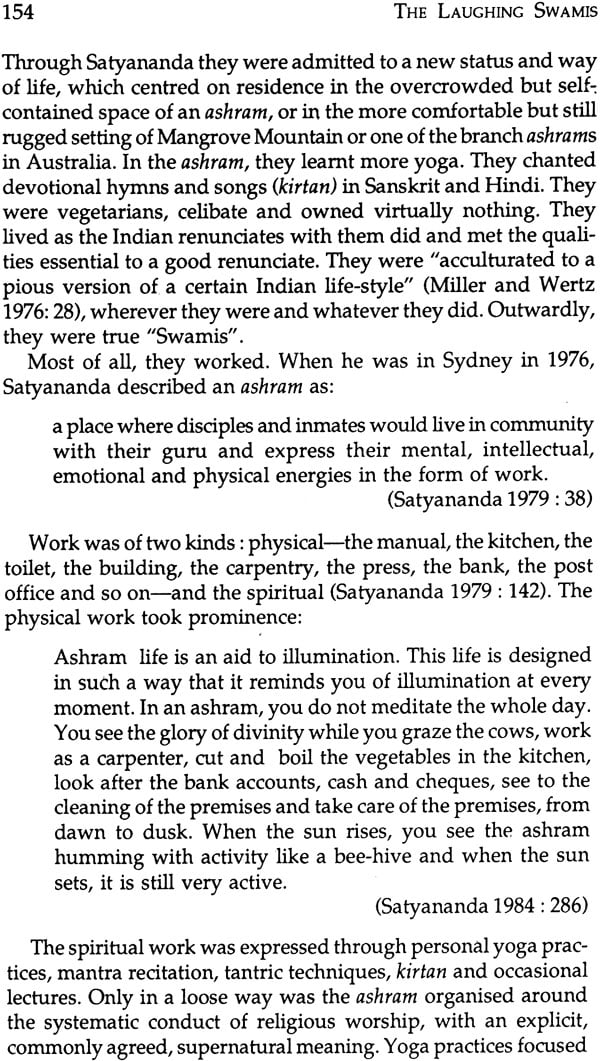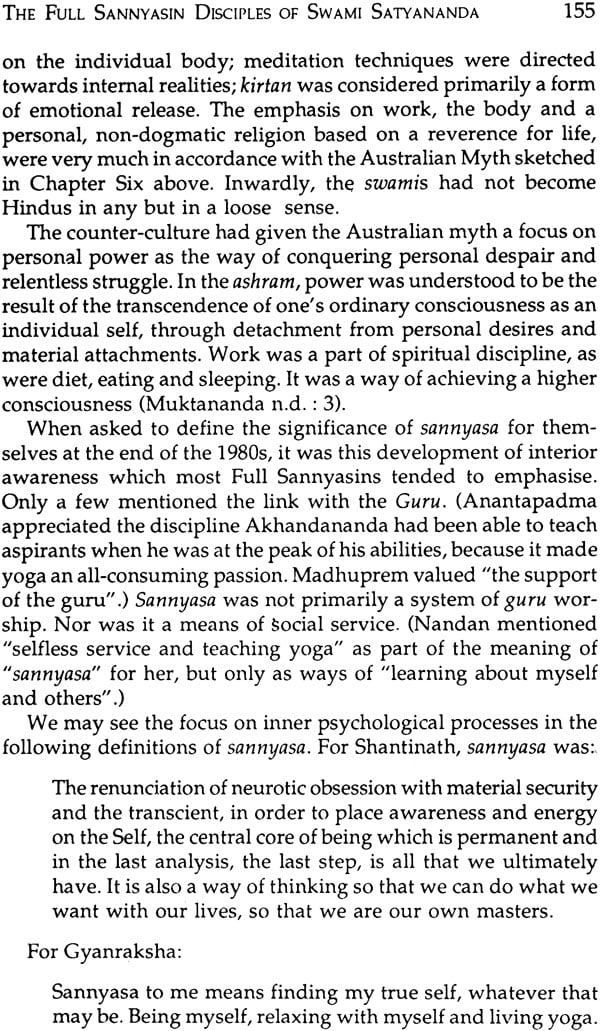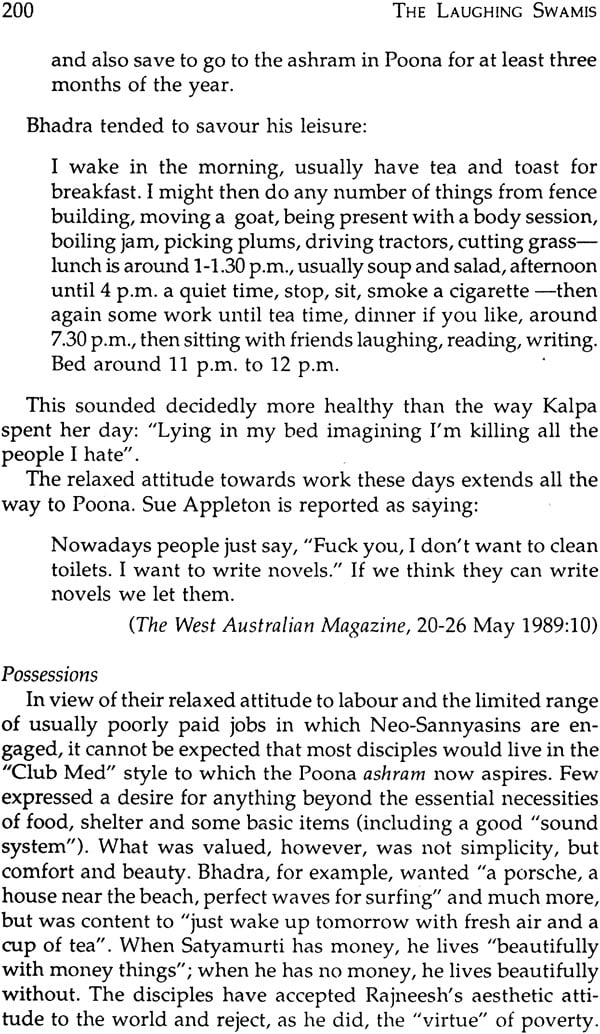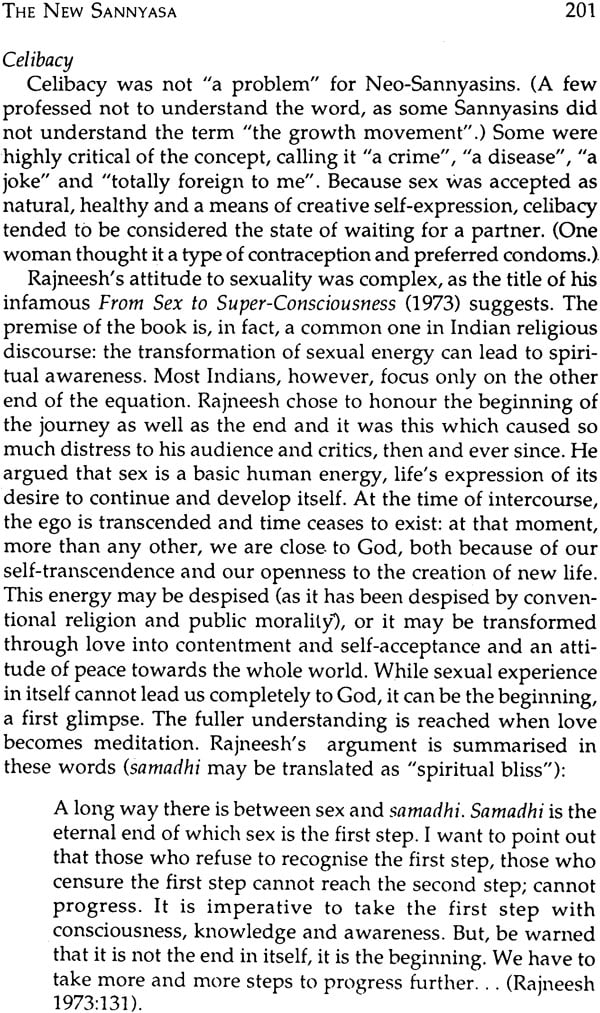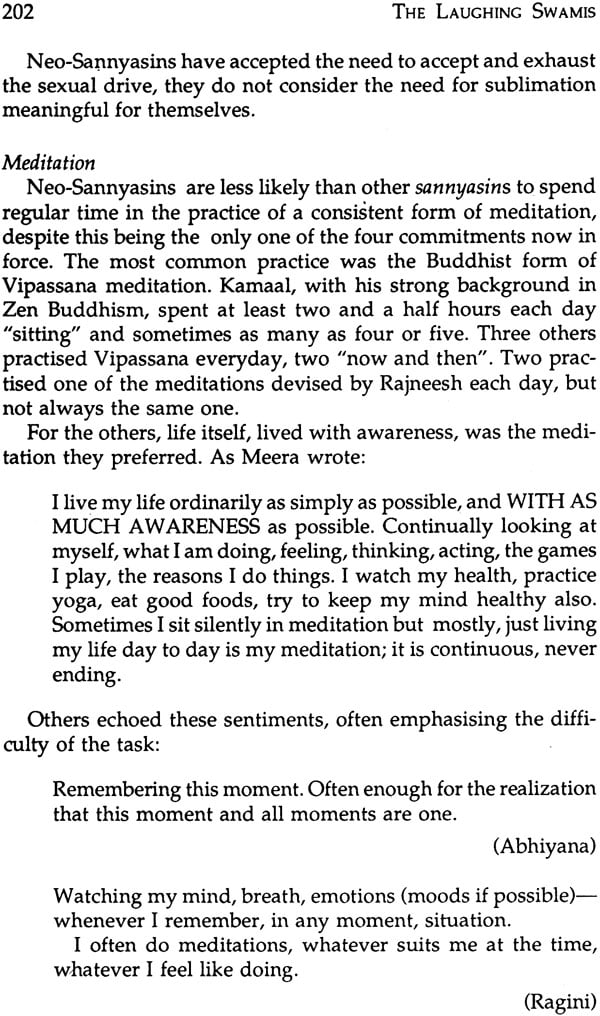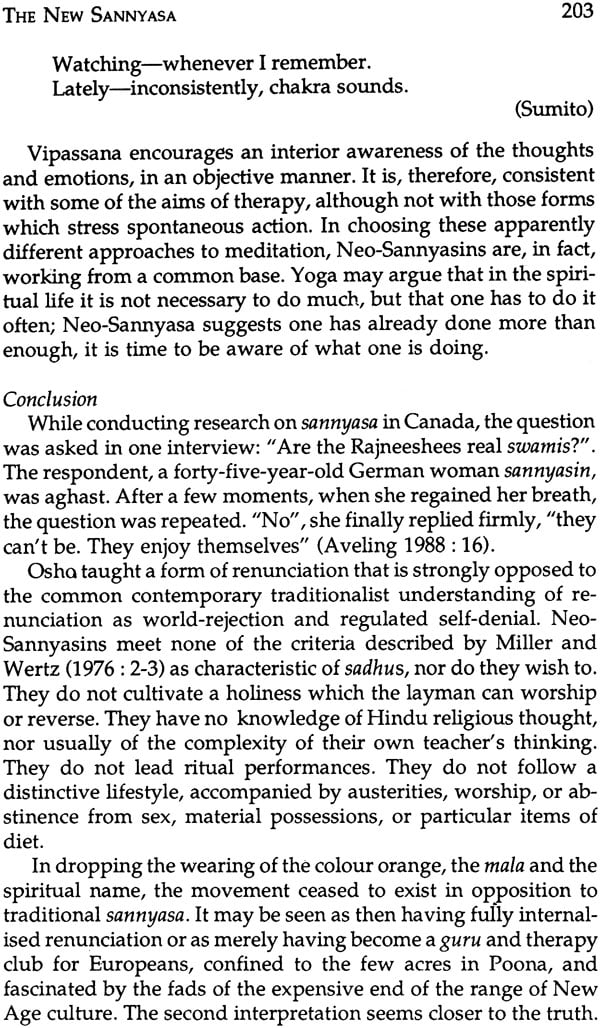
The Laughing Swamis (Australian Sannyasin Disciples of Swami Satyananda Saraswati and Osho Rajneesh)
Book Specification
| Item Code: | IDJ558 |
| Author: | Harry Aveling |
| Publisher: | Motilal Banarsidass Publishers Pvt. Ltd |
| Language: | English |
| Edition: | 1996 |
| ISBN: | 8120811186 |
| Pages: | 239 |
| Cover: | Paperback |
| Other Details | 8.5 inch X 5.5 inch |
| Weight | 310 gm |
Book Description
Back of the Book
In 1895 Swami Vivekananda of the Ramakrishna Mission initiated two Europeans, one a woman, into the ancient Indian tradition of sannyasa or world-renunciation. This practice was continued in the first part of the twentieth century by Swami Shivananda of Rishikesh. From the late sixties onwards, with the sudden expansion of European awareness of Indian Spirituality, a vast hord of "foreign religious heads" have spread through India in incomprehensibly large numbers (to quote Gita Mehta in Karma Cola). Many thousands of these have assumed the orange robes, beads and Sanskrit names of the Indian renunciate, for various periods of time and with differing degrees of commitment. Foremost in initiating Western disciples during this time have been Swami Satyananda Saraswati, a wandering (parivrajaka) mendicant, and the late Bhagwan Shree Rajneesh (or "Osho" as he was known prior to his death).
Who were these disciples? What were their backgrounds in their own societies? What did sannyasa mean to them? How did they live in their ashrams and residences, in India and abroad? How had they changed when they returned to the West?
This book seeks to answer these questions with reference to the Australian disciples of Satyananda and Osho. It provides a careful study of both Indian concepts and practices of renunciation and of the western "Counter Culture" of the sixties, which formed an integral part of the background of these seekers. The teachings of Satyananda and Rajneesh on renunciation are analyzed in depth. Finally, the major part of the book is devoted to a description of the lives and experiences of the renunciates themselves.
Harry Aveling was born in Sydney, Australia in 1942. He holds postgraduate degrees in Arts (Indonesian and Malay Studies), Education (Multicultural Studies) and Theology (Franciscan Spirituality and Theology). Translator of over fifty volumes of Indonesian and Malay literature, he was awarded the Anugerah Pengembangan Sastra EssoGapena for his contributions to the international recognition of Malay Literature, in 1991. He is currently attached to the Department of Malay Studies, National University of Singapore.
Preface
This book aims to study the reinterpretation of the ancient Indian tradition of world-renunciation, sannyasa, by two contemporary teachers, Swami Satyananda (b.1923), and Osho (1931-1990) otherwise known as Bhagwan Shree Rajneesh.
The major focus of the study is on Australians who were disciples of these teachers during the seventies and eighties. In particular, the work seeks to describe the cultural settings for renunciation both in India and in Australia after 1965; and to explore the motive, understanding and lifestyles of the Australians who became sannyasin disciple of these two teachers. In this Preface I would like to provide an overview of the whole work.
The study is based on a wide range of texts, including classical scriptures, ethnographies, talks in which Satyananda and Rajneesh explained their position on renunciation, and the replies to a 'Questionnaire on Sannyasa' provided by sixty-seven respondents: twenty full sannyasin initiates and twenty-two 'householder sannyasin' disciples of Rajneesh. Part One serves as an introduction to the volume and deals with the methodology used- an analysis of 'discourses', and the problems related to the distribution of the questionnaire to a dispersed, unmodified, self-protective population.
Part Two presents the traditional Indian theory and practice of renunciation. Sannyasa was considered the last of four life-stages. It has been interpreted in various ways in the scriptures: as a continuous state of divine ecstasy outside the conventional society, by the Vedas; as a form of self-control based on knowledge of the Self (atman) and God (Brahman, the Ground of Being), in the Upanishads, as a defined code of practice, with specific external insignia, grades and obligations, in the sannyasa Upanishads; and as a state of inner detachment from the consequences of one's action (karma), in the Bhagavad-Gita.
Contemporary sociological research suggests that renunciates in India are expected to wear the insignia of their order; to be characterized by the quality of 'holiness'; to have some knowledge of Sanskrit texts, and skill in ritual or devotional leadership; and to follow a distinctive lifestyle based on asceticism and physical restraint (including sexual celibacy). Most renunciates derive from small joint families of the Brahmin caste, particularly those engaged in farming. Most are also illiterate, and rely on begging for their food and other needs. Although some sannyasins are initiated before the age of thirty, most are initiated after this age and many after the age of sixty. For most, a desire to lead a spiritual life is less important than the opportunity to follow a convenient and respectable existence. Some Europeans have joined orders of mainly Western renunciates, which seek to maintain a lifestyle similar to those of Indian renunciates. Unlike their Indian counterparts, these Western renunciates have been aged in their twenties at the time of first joining, been well-educated (often to tertiary level), were single or divorced, and have expressed a strong need to understand the world in religious terms.
Part three concentrating with the lives and teachings of Satyananda and Osho. By concentrating on the 'inner essence' of sannyasa, both have sought to justify the extension of renunciation to non-Indians, non-Hindus, and women. Of the two teachers, Rajneesh was the more radical, in that he sought to use the inner essence of sannyasa as a means of attacking what he considered to be abuses of contemporary renunciate lifestyles in India.
Part Four deals with the experiences of Australian renunciates and forms the major part of the study.
Chapter Six shows the limited position of religion in the Australian society, and the unusual place of Asian-based religions in a Christian, materialist and racist society. Such religions are most likely to appeal to those who are not well-integrated into the mainstream of society and are available to the adoption of new and unusualidentites. The rise of the 'counter-culture' in the last 1960s and throughout the seventies created such a situation. Chapter Seven presents the main features of the counter-culture, beginning with the opposition to the war in Vietnam, and moving to more personal issues such as feminism, new arrangements of shared accommodation, new concepts of 'personal power', particularly as developed in the 'growth movement' which was a part of Humanistic Psychology, the use of drugs, and the rise of movements devoted to 'eastern mysticism' including the practice of yoga.
Australians attracted to a commitment to either Swami Satyananda or Osho had backgrounds similar to those of the other Western renunciates described above. They were usually under the age of thirty, well educated, with some religious background in a mainstream Christian denomination, and often single or recently divorced. The demographic details of the respondents are summarized in Chapter Eight. In this chapter it is suggested that three cohorts can be distinguished among each of the group of full sannyasins, householder sannyasins and neo-sannyasins. The first cohort took initiation in the seventies, often in India, and were closest to the values of the counter-culture. The second cohort, who took initiation in the early to mid-eighties, moved into a known and defined situation, and spent less or no time in India. The third cohort have joined after the major collapse of both movements in the later part of the eighties, and exhibit distinctively individual reasons for joining. Members of the second and third cohorts show less attachment to the values of the counter-culture than do members of the first cohort. Nevertheless, all belong to what Mannheim (1952:306) has described as a 'generational unit', a group o persons with a common psychological and emotional perception of the world and characteristic way of behaving.
Chapter Nine, Ten and Eleven describe each group in detail by turn. The chapter follow a similar pattern, beginning with the life of a representative member of the group; the experiences of the different cohorts and the changing understandings of discipleship; the lifestyle of the major ashram or place of training and finally a survey of current work patterns, attitudes to celibacy, and spiritual practices.
Chapter Nine shows the structured and disciplined life led by full sannyasin disciples of Swami Satyananda, and their methods of readjusting to the Australian society after lengthy residences in India. Chapter Ten describes householder sannyasins, the most recent of the three groups, who follow an ethic dedicated to the sacralisation of their present work and family patterns. Chapter Eleven is concerned with neo-sannyasins, who, on the other hand, accept an unstructured lifestyle, in which a major emphasis is placed on Rajneesh as an object of emotional focus and on psychological therapeutic techniques as the major means for self-awareness. The Rajneesh community also places little stress on discipline or poverty, preferring spontaneity and beauty. Neo-sannyasins have lower levels of education than Satyananda's disciples, less commitment to rewarding work, and spend little time practicing meditation. In view of the decision to drop the wearing of the external signs of renunciation in 1987, it must be questioned whether neo-sannyasa now has anything in common with other renunciate movements, either positively or in contradiction to them. Ironically, it is noted that with the increasing loss of interest in the Indian ashram by overseas visitors, the ashram is tending to become a memorial to Rajneesh; the tradition has absorbed his challenge and given him the status of a great teacher.
The Postscript suggests that both movements have been unable to survive the moral shortcomings of their top leadership in the middle of the last decade and are now dying. What promised to be innovative transformations of an ancient spirituality, in accordance with contemporary needs and ways of thought, have come to nothing.
This study is an extension of work done on Canadian renunciates in 1988. The challene to turn my interest to Australian renunciates first came from Swamis Karuna Devi and Bhav-chaitanya, organizers of the 1989 Yoga and Meditation Festival, Melbourne.
The research was conducted during 1989-1990 and presented to the University of New England, Armidale, New South Wales, towards the degree of Master of Education in Multicultural Studies in March 1991. Dr. A.K. Eckermann was a patient and gracious supervisor. I am also grateful for the interest, hospitality and insights of Dr. G. Gunther, my associate supervisor.
Encouragement and support was given by many sannyasins. Particular mention must be made of Swamis Ajnananda, Jivan Christopher, Deva Daricha, Devanatha, Karmamurti, Muktananda, Muktibodhananda, Naradananda, Sambodh Roman, Shankardevananda and Tapasmurti and Ma Anand Kalpana, Prem Maneesha, Rajni and Shivam Rachana, who facilitated this work in many ways. Ma Anand Ruchita has suffered the complexities and paradoxed yet to be resolved in the heads of many sixties people and knows how much the seeing eye is part of what is seen.
Mrs. Coleen Clavdivs first typed an earlier version of the chapter on Osho. Mrs. Satwant Kaur typed the entire manuscript with care and good humor. Blessings on her son, Sandip, who was born during this time. Ms. Catherine Welch helped with the proof-reading; to her too I offer my sincere thanks.
The responsibility for this work is my own, as must be the karma associated with it.
| Preface to the Second Printing | ix | |
| Preface | xi | |
| The Laughing Swamis | xvii | |
| | ||
| Chapter1: | Multiple voices:On Methodology | 3 |
| Research as Discourse | 5 | |
| Problems of Dialogue | 7 | |
| Questionnaire on Sannyasa | 10 | |
| Sannyasa is not a Text | 12 | |
| | ||
| Chapter2: | The Classical Indian Tradition of Renunciation | 15 |
| Life Stages | 16 | |
| The Vedas: Renunciation as Ecstasy | 17 | |
| The Major Upanishads: Renunciation as Knowledge | 19 | |
| The Sannyasa Upanishads: Renunciation as World-Abandonment | 26 | |
| Bhagavad Gita: Renunciation as Yoga | 30 | |
| Chapter3: | CLASSICAL INDIAN RENUNCIATE LIFESTYLES | 37 |
| History of Renunciation | 38 | |
| Sociological Studies of Traditional Renunciation | 41 | |
| Bhubaneswar | 42 | |
| Uttar Pradesh | 45 | |
| Western Renunciates: The Sannyasin Disciples of Swami Vishnu Devananda | 47 | |
| Hare Krishna (ISKCON) | 49 | |
| Conclusion | 54 | |
| | ||
| Chapter4: | SATYANANDA AND INNER RENUNCIATION | 59 |
| Swami Satyananda | 60 | |
| Sannyasa Tantra | 62 | |
| Karma Sannyasa | 65 | |
| Conclusion | 69 | |
| Chapter5: | OSHO AND NEO-SANNYASA | 71 |
| Rajneesh | 71 | |
| The Path of Love | 78 | |
| God | 79 | |
| Human Existence | 80 | |
| Mind and Illusion | 81 | |
| The Search for Truth | 82 | |
| Renunciation | 85 | |
| | ||
| Chapter6: | RELIGION AND ASIAN RELIGIONS IN AUSTRALIA | 91 |
| The Denominational Experience | 91 | |
| Religiousness in Australia | 92 | |
| The Australian Myth | 93 | |
| Asian Religions | 95 | |
| Switching to an Asian Religion | 95 | |
| Conclusion | 97 | |
| Chapter7: | THE "COUNTER-CULTURE" | 99 |
| The End of an Era | 99 | |
| The Vietnam War | 101 | |
| Other Public Protest Movements | 103 | |
| The New Consciousness | 104 | |
| Feminism | 105 | |
| The Family | 106 | |
| Shared Living | 106 | |
| Personal Power and self understanding | 107 | |
| The Growth Movement | 107 | |
| Drugs and "Eastern Mysticism" | 109 | |
| The Ageing of the Counter-Culture | 111 | |
| Chapter8: | BACKGROUNDS TO SANNYASA | 113 |
| I: Demographic Background | 113 | |
| Gender | 113 | |
| Age | 114 | |
| Place of Origin | 115 | |
| Religion | 116 | |
| Education | 117 | |
| Marriage | 118 | |
| Demographic Background: Conclusion | 123 | |
| Chapter9: | THE FULL SANNYASIN DISCIPLES OF SWAMI SATYANANDA | 141 |
| Ram Giri Baba | 141 | |
| I. Taking Full Sannyasa: Swami Haribhakti Saraswati | 142 | |
| The First Full Sannyasin Cohort | 145 | |
| The Second Cohort | 149 | |
| The Third Cohort | 153 | |
| II: Living in the Ashram | 153 | |
| Leaving the Ashram | 161 | |
| III. Living in Australia | 163 | |
| Chapter10: | HOUSE HOLDER SANNY ASINS | 165 |
| I. Taking Karma Sanny: Swami Tulsimala Saraswati | 165 | |
| The First Cohort | 168 | |
| The Second Cohort | 169 | |
| The Third Cohort | 171 | |
| The Meanings of Initiation | 172 | |
| II. Living in the World | 176 | |
| All Sannyasins Together | 179 | |
| Chapter11: | THE NEW SANNYASA | 181 |
| I. Taking Neo-Sannyasa: Swami Ananda | 182 | |
| Coming to the Master | 185 | |
| The First Cohort | 185 | |
| The Second Cohort | 187 | |
| The Third Cohort | 189 | |
| Sex | 189 | |
| II. The Buddha Field | 190 | |
| Shree Rajneesh Ashram | 191 | |
| Oregon | 193 | |
| The Centres | 194 | |
| Headlong into the Temple of Ruin | 195 | |
| The Return to Poona | 197 | |
| III. Living at the End of the Eighties as a Non-Serious Neo-Sannyasin | 199 | |
| Work | 199 | |
| Possessions | 200 | |
| Celibacy | 201 | |
| Meditation | 202 | |
| Conclusion | 203 | |
| Postscript | 205 | |
| Appendix | 207 | |
| Glossary | 211 | |
| bibliography | 213 |
